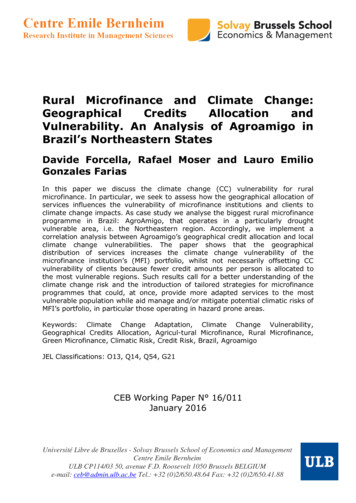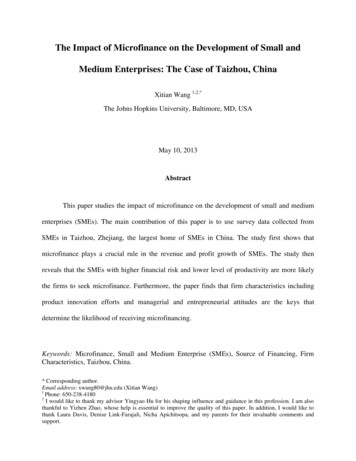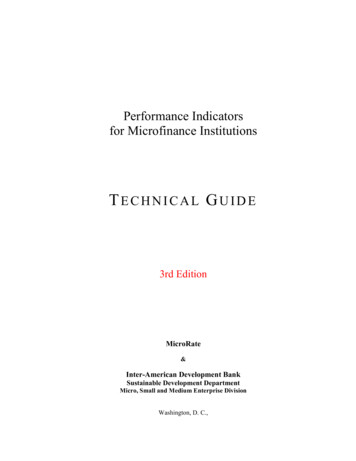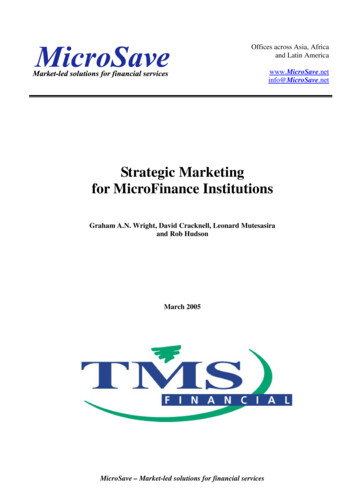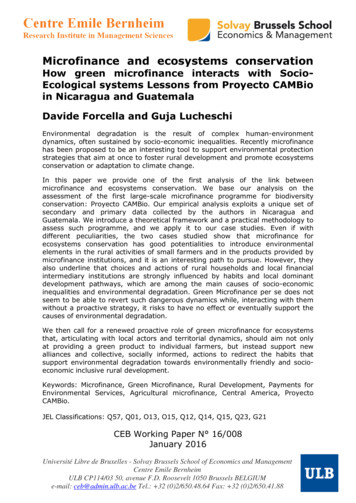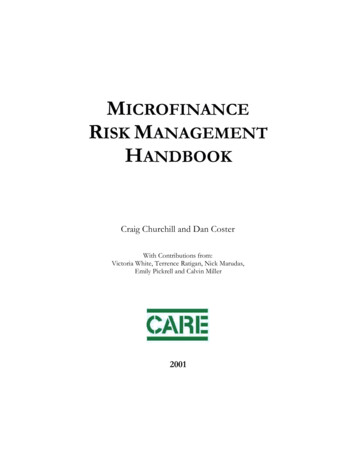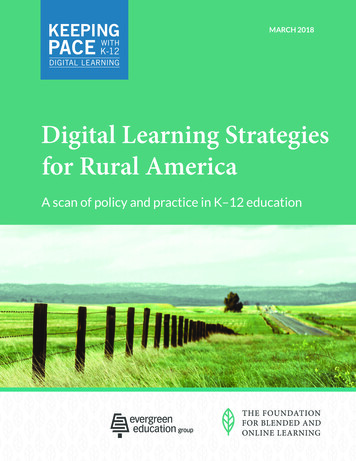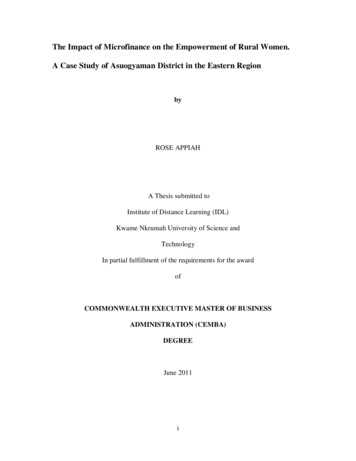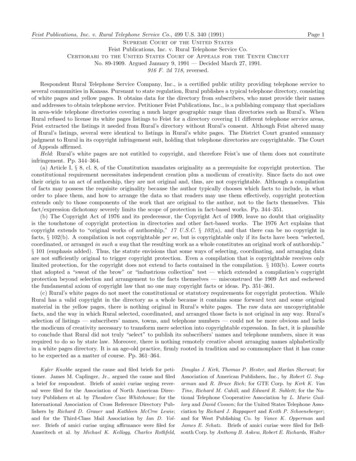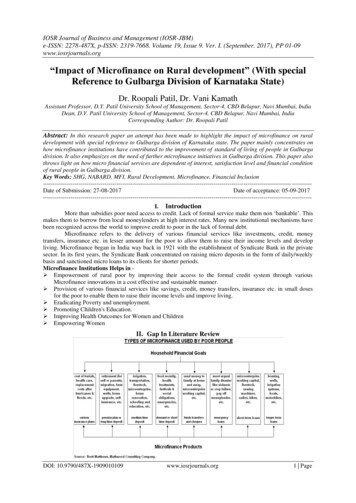
Transcription
IOSR Journal of Business and Management (IOSR-JBM)e-ISSN: 2278-487X, p-ISSN: 2319-7668. Volume 19, Issue 9. Ver. I. (September. 2017), PP 01-09www.iosrjournals.org“Impact of Microfinance on Rural development” (With specialReference to Gulbarga Division of Karnataka State)Dr. Roopali Patil, Dr. Vani KamathAssistant Professor, D.Y. Patil University School of Management, Sector-4, CBD Belapur, Navi Mumbai, IndiaDean, D.Y. Patil University School of Management, Sector-4, CBD Belapur, Navi Mumbai, IndiaCorresponding Author: Dr. Roopali PatilAbstract: In this research paper an attempt has been made to highlight the impact of microfinance on ruraldevelopment with special reference to Gulbarga division of Karnataka state. The paper mainly concentrates onhow microfinance institutions have contributed to the improvement of standard of living of people in Gulbargadivision. It also emphasizes on the need of further microfinance initiatives in Gulbarga division. This paper alsothrows light on how micro financial services are dependent of interest, satisfaction level and financial conditionof rural people in Gulbarga division.Key Words: SHG, NABARD, MFI, Rural Development, Microfinance, Financial ---------------------------------- ---------Date of Submission: 27-08-2017Date of acceptance: ----------------------------------- ---------I. IntroductionMore than subsidies poor need access to credit. Lack of formal service make them non ‘bankable’. Thismakes them to borrow from local moneylenders at high interest rates. Many new institutional mechanisms havebeen recognized across the world to improve credit to poor in the lack of formal debt.Microfinance refers to the delivery of various financial services like investments, credit, moneytransfers, insurance etc. in lesser amount for the poor to allow them to raise their income levels and developliving. Microfinance began in India way back in 1921 with the establishment of Syndicate Bank in the privatesector. In its first years, the Syndicate Bank concentrated on raising micro deposits in the form of daily/weeklybasis and sanctioned micro loans to its clients for shorter periods.Microfinance Institutions Helps in Empowerment of rural poor by improving their access to the formal credit system through variousMicrofinance innovations in a cost effective and sustainable manner. Provision of various financial services like savings, credit, money transfers, insurance etc. in small dosesfor the poor to enable them to raise their income levels and improve living. Eradicating Poverty and unemployment. Promoting Children's Education. Improving Health Outcomes for Women and Children Empowering WomenII. Gap In Literature ReviewDOI: 10.9790/487X-1909010109www.iosrjournals.org1 Page
“Impact of Microfinance on Rural development” (With special Reference to Gulbarga Division of .There are certain key characteristics of the rural poor with regard to their credit needs. Majority of themwork as casual labour in the informal sector as hawkers, home-based producers and manual labor such ashousemaids. Their credit needs often arise out of uncertain earnings and consequent disruption in their cashflow, medical emergencies, household needs and extortions by lawful or unlawful actors (Gaiha, 2005). There islack of documented data about the impact of microfinance on rural development in Gulbarga division ofKarnataka state. The present study attempts to examine analytically the impact of microfinance on ruraldéveloppent in Gulbarga division of Karnataka state.Objectives of the Study1. To know the impact of micro financial services initiatives on rural development of Gulbarga division.2. To know whether there is need for microfinance initiatives in Gulbarga Division.3. To assess the satisfaction level of microfinance clients for Microfinance services offered by MicrofinanceInstitutions in Gulbarga Division.4. To identify whether the Micro financial services initiatives are dependent of the interest and financialconditions of rural people.5. To throw light on role played by Micro Financial institutions in Improving standard of living of ruralpeople of Gulbarga division.Hypothesis of Study:H0: There is no significant association between Micro-financial Services Initiatives and Rural Development.H01: There is a significant association between Micro-financial Services Initiatives and Rural Development.H02: There is no significant association between Micro financial Services offered and satisfaction level ofmicrofinance clients in Gulbarga DistrictH12. There is significant association between Micro financial Services offered and satisfaction level ofMicrofinance clients in Gulbarga DistrictH03: Micro financial services initiatives are not dependent of the interest and Financial conditions of ruralpeople.H13. Micro financial services initiatives are dependent of the interest and Financial conditions of rural peopleH04: Involvement of Micro -Financial Institution does not improve the standard of living of Poor families.H14: Involvement of Micro -Financial Institution significantly improves the standard of living of Poor families.III. Literature ReviewOtero (1999), illustrates the various ways in which “microfinance, at its core combats poverty”. She states thatmicrofinance creates access to productive capital for the poor, which together with human capital, addressedthrough education and training, and social capital, achieved through local organisation building, enables peopleto move out of poverty (1999). By providing material capital to a poor person, their sense of dignity isstrengthened and this can help to empower the person to participate in the economy and society (Otero, 1999).Goankar, Rekha. (2001), the study resolved that the program of SHGs can considerably add towards thedecline of poverty and unemployment in the rural sector of the economy and the SHGs can lead to social changein terms of economic growth and the social modification.Jayasheela, Dinesha P T and V.Basil Hans (2008), in their paper on “Financial inclusion andmicrofinance in India: An overview” studied the role of microfinance in the empowerment of people andprovision of a sustainable credit availability to the rural low income population. The study relates to theopportunities available for the microfinance institutions with an increasing demand for credit in the rural areasdue to inadequate formal sources of credit.Verma, Renu.(2008), in her article concludes that microfinance is expected to play a significant role in povertyalleviation and rural development [J. Ref.No.30,P/163]. Microfinance has, in the recent past become one of themore premising ways to use core development funds to achieve the objectives of poverty alleviation. Further hestated that certain microfinance programs have gained prominence in the development field and beyond. Theultimate aim is to attain social and economic empowerment. These microfinance institutions may very well havehad a major impact on improving the standard of living of millions of poor people as well as on promotingeconomic development. Therefore microfinance has become one of the utmost active involvements foreconomic enablement of the poor.Vani Kamath (2010), “Finding usage in access to banking and scope for microfinance in Gulbarga District,Karnataka: A study of Financial Inclusion on Below Poverty Line Families” summarized in the thesis the pointslike There is a significant difference between Financial inclusion and lack of awareness by rural households.There is a significant difference between the financial inclusion and institutional negligence by banks. There is asignificant difference between household perceptions about the formal and informal sources of finance. There isDOI: 10.9790/487X-1909010109www.iosrjournals.org2 Page
“Impact of Microfinance on Rural development” (With special Reference to Gulbarga Division of .a significant difference between access to a savings account and usage of that account. There is no significantdifference in the perceptions of households between Self Help Group Savings and chit funds.Ravikumar, (2016), “Contribution of Microfinance in empowering the women entrepreneurs in Gulbarga city”concluded in his article women entrepreneurs have been empowered in the different sections of their businessoperations and social status under the dynamic guidance and support of micro finance institutions and if womenentrepreneur is given a proper guidance and training further that will definitely enhance the profitability of theenterprises and the future will be bright and prosperous.IV. Research MethodologyThe study is an empirical one based on sample survey method. The study is basically dependent onprimary data. The required primary data was collected by means of a questionnaire distributed in Gulbargadivision. The secondary data was collected from the national and internationalE-journals, Research articles, books and reports published by RBI, NABARD, and Newspapers etc.Gulbarga district is backward and nearly 40% of rural populations are away from banks. Thus, not formalcredit delivery system plays very vital role in the Gulbarga district.The sample is designed such that the study is NOT representative of any one MFI but representsresponses of MFI clients in Gulbarga as a whole. Microfinance clients from Microfinance Institutions located inGulbarga Division i.e from,S.K. S. Microfinance Institute, Spandana Spoorthy Microfinance ,ShareMicrofinance Institute, L& T Microfinance, Janalaxmi, Grameena Koota, Outreach Microfinance, HDFCMicrofinance and Samruadhi Microfinance are selected for study purpose.The total samples selected for the study was 485 respondents. Respondents were selected randomlyirrespective of age, education and income level from Gulbarga district.V. Data Analysis And InterpretationValidation of the QuestionnaireThe study uses structured questionnaires for the collection of primary data on perception of Micro-financialservices and role of MFI in selected research area. They were validated after the pilot study and the Cronbach’sAlpha scores for each questionnaire were found as follows:Questionnaires ItemsSocial and Economical ParameterService SatisfactionAsset based IndicatorGulbarga.866.822.783No of Items121016Table no. Cronbach’s Alpha Scores (Validation of the Questionnaire)1. Social and Economical Parameters:This is one of the most important elements in understanding the impact of MFI in Rural Development.Validation results show that Cronbach’s Alpha Scores is .866 which is highly satisfying scores to carry on theresearch in right direction.2. Service Satisfaction :The another important factor is Service satisfaction which is showing .822 Cronbach’s Alpha Scores which isalso highly satisfying to go ahead with the selected questionnaires items.3. Asset based Indicator:This indicator is showing the difference in assets creation before and after Micro financial services introduced tosample population. Cronbach’s Alpha Scores is .783, is quite convincing in understanding the items selectionfor questionnaire.Hypothesis- 01H00: There is no significant association between Micro-financial services initiatives and ruraldevelopment.H11: There is a significant association between Micro-financial services initiatives and rural development.Data Interpretations: Chi –square test has been applied to create the proof whether there is a noteworthyrelationship exist between Micro-financial services initiatives and rural development or not.DOI: 10.9790/487X-1909010109www.iosrjournals.org3 Page
“Impact of Microfinance on Rural development” (With special Reference to Gulbarga Division of .Case Processing SummaryCasesValidMissingNSatisfaction with MFS *485Improvement in 85100.0%Satisfaction with MFS * Improvement in Livelihoods Cross tabulationImprovement in LivelihoodsSatisfactionMFSwith StronglyDisagreeDisagree 5.0Chi-Square TestsPearson Chi-SquareLikelihood RatioLinear-by-Linear AssociationN of Valid CasesValuedfAsymp. Sig. (2sided)1.506E2a59.26212.523485991.000.000.000a. 5 cells (31.3%) have expected count less than 5. The minimumexpected count is .26.Symmetric MeasuresValueAsymp.ErroraStd.Approx. Tb Approx. Sig.aNominal by Nominal Contingency Coefficient .487.000Interval by IntervalPearson's R.161.0493.582.000cOrdinal by OrdinalSpearman Correlation.109.0412.421.016cN of Valid CasesDOI: 10.9790/487X-1909010109485www.iosrjournals.org4 Page
“Impact of Microfinance on Rural development” (With special Reference to Gulbarga Division of .a. Not assuming the null hypothesis.b. Using the asymptotic standard error assuming the null hypothesis.c. Based on normal approximation.Results: Chi Square test has been utilized to see the association between Micro-finance service initiatives andrural development and the chi square calculated value which is .000, significantly lower than p value.05; sorejecting the null hypothesis and establishing the evidence that there is a significance association betweenMicro-financial Services initiatives and rural development in selected districts.Hypothesis-02H02: There is no significant association between micro financial Services offered and satisfaction level inGulbarga DistrictH12. There is significant association between micro financial Services offered and satisfaction level inGulbarga DistrictInterpretation:Chi Square test has been used to see whether there is any significant association exists in need of micro financialservices and Micro- financial services satisfaction in given sample size considering the Dwelling and FoodFactor along with Services offered.CasesValidNNeed of 0%0.0%200100.0%Need of Micro-Financial services * Micro financial Services Satisfaction Cross otal06184.93.518.01616Expected Count 8.64.33.116.0Count5227143Expected Count 76.538.627.9143.0Count1023Expected Count 12.36.24.523.0Count543920054.039.0200.0Need of Micro-Financial Strongly Disagree Count12servicesExpected Count 9.6DisagreeAgreeStrongly AgreeTotalCount96422107Expected Count 107.0DOI: g5 Page
“Impact of Microfinance on Rural development” (With special Reference to Gulbarga Division of .Chi-Square TestsPearson Chi-SquareLikelihood RatioLinear-by-LinearAssociationN of Valid CasesValuedfAsymp. Sig. (2sided)35.653a45.82866.000.0004.3111.038200a. 5 cells (41.7%) have expected count less than 5. The minimumexpected count is 3.12.Directional MeasuresNominalNominalby UncertaintyCoefficientValueAsymp. Std. rvices ncialDependentMicrofinancialServices Satisfaction .114Dependenta. Not assuming the null hypothesis.b. Using the asymptotic standard error assuming the ity.Symmetric MeasuresNominal by NominalN of Valid CasesContingency CoefficientValueApprox. Sig.389200.000Results: Chi Square test applied and Pearson chi-square calculated value which is .000 is lower than the pvalue of 0.05; hence null hypothesis stands rejected and establish the fact that there is significant associationbetween satisfaction level of clients and microfinance initiative and there is more need of Micro finance servicesin Gulbarga District.Hypothesis -3H03 – Micro finance service initiatives are not dependent of the interest & financial condition of ruralpeople.H13 - Micro finance service initiatives are dependent on the interest & financial condition of rural people.Interpretation:The chi square test has been applied to see if there any significant association is there between the economical orfinancial status of the people and Micro finance service offered in the researchable area. Cross tabulation wasconducted between economic impact and MFS Satisfaction level to understand the association between both thefactors whether it exist and independent in their nature.DOI: 10.9790/487X-1909010109www.iosrjournals.org6 Page
“Impact of Microfinance on Rural development” (With special Reference to Gulbarga Division of .Table 1. Case Processing SummaryCasesValidNEconomical impact * MFS485satisfaction 485100.0%Table 1.1Economical impact * MFS satisfaction level Cross tabulationMFS satisfaction levelEconomical impactIncrease/improvedNo changeDecrease/ReducedTotalHighMedium LowTotalCount3228321426Expected Count320.687.018.4426.0Count2810038Expected Count28.67.81.638.0Count156021Expected Count15.84.3.921.0Count3659921485Expected Count365.099.021.0485.0Table : 1.3 Chi-Square TestsValuePearson Chi-SquareLikelihood RatioLinear-by-Linear AssociationN of Valid Cases4.4826.893.050485adfAsymp. Sig. (2-sided)441.345.142.824a. 3 cells (33.3%) have expected count less than 5. The minimum expected count is .91.Table1.4 Symmetric MeasuresValueNominal by NominalInterval by IntervalOrdinal by OrdinalN of Valid CasesContingency CoefficientPearson's RSpearman .Approx. TbApprox. Sig.a-.222.237.345.824c.812ca. Not assuming the null hypothesis.b. Using the asymptotic standard error assuming the null hypothesis.c. Based on normal approximation.DOI: 10.9790/487X-1909010109www.iosrjournals.org7 Page
“Impact of Microfinance on Rural development” (With special Reference to Gulbarga Division of .Result: The result of chi square test is where calculated value of Pearson chi-square is .345 which is lesser thanthe tabulated value of p (0.05) which is 9.488; hence we reject the null hypothesis and establish the evidencethat the Micro financial services initiatives are dependent on the interest & financial condition of rural people.Hypothesis- 04H04: Involvement of Micro -Financial Institution does not improve the standard of living of rural peoplein selected district.H14: Involvement of Micro -Financial Institution significantly improves the standard of living of ruralpeople in selected district.Interpretation: Paired Sample T-Test used to analyze the pre and Post effect of Micro-Financial Institutions inimproving standard of living of Below-Poverty- Lines Populations.Here 16 items were selected to understand the impact of MFI’s on Standard of livings for the given 485respondents in selected districts.Paired Samples StatisticsPair 1MeanNStd. DeviationStd. Error MeanAcquired before MFS2.0616.854.213Acquired after MFS3.3116.704.176Paired Samples CorrelationsNPair 1Acquired before MFS &16Acquired after MFSCorrelationSig.-.811.000Paired Samples TestPaired nPair1Std.Std. ErrorDeviation MeanLowerAcquiredbeforeMFS - Acquired -1.250 1.483after MFSDOI: 10.9790/487X-1909010109.371-2.040Uppert-.460-3.371 15www.iosrjournals.orgdfSig.(2tailed).0048 Page
“Impact of Microfinance on Rural development” (With special Reference to Gulbarga Division of .Results: The outcome of the Paired Sample T-test explicitly indicates, where the P- value (.004), which islower than .05, that Involvement of micro-financial institutions are significantly improving the standard of lifeof rural people in selected Districts.VI. ConclusionIn a nut shell, we can say Microfinance tries to overcome the short comings and failures of the existingfinancial institutions and development programmes by providing adequate and hassle free finance to the needyand also acts as gap filler in the formal institutional network for providing small finance to poor people.Gulbarga District has been in the forefront in the adoption of Micro finance operations. Micro financecreated a fruitful atmosphere in Gulbarga district. Various NGOs/SHPIs have working actively. Financialinstitution viz., Commercial Banks, Regional Rural Banks and Gulbarga District Central Cooperative Bank arealso playing the key role of “Credit Purveyor” to SHGs. Government sectors are promoting “Stree Shakti”Groups on the basis of sources available about 62% of the households eligible to be covered under SHG. Thereare about 65,763 Marginal farmers and 130271 small farmers' families in the district. The district has in all 47NGOs in which 16 are actively involved in promotion/Nurturing of SHGs. There are six major MFIs operatingactively in the district by providing credit to rural people.To sum up, it can be noticed from overall analysis that there is significant impact of microfinanceactivities on improvement of the living standard of the family not only in economic term but also in social term.From this study, conclusion can be drawn that there is a noticeable and positive impact of microfinanceactivities on the living standards, empowerment and poverty alleviation among the poor people in the society.There are MFIs active in Gulbarga. Further it is observed that the share of the poor in the portfolio ofthese MFIs is noticeably higher than in the other three regions i.e. Bangalore, Belgaum and Mysore, Gulbargamay not meet the expectations of stakeholders in terms of potential scale. There are MFIs active in the areaalready serving the poor and they provide a strong option to the regulator to further expand financial inclusionefforts in Gulbarga.A place like Gulbarga which is the less developed districts of the country is a big task to themicrofinance model to revolutionize on multiple fronts including products, processes and technologies. There isa need for Microfinance Initiatives in Gulbarga division as it has a positive impact on rural development inGulbarga division.The study is confined to Gulbarga division of Karnataka state, the division consists ofGulbarga,Raichur,Bidar,Yadgir and Koppal each district has lot of potentiality to develop MicrofinanceInstitutions. Compared to the four different regions of Bangalore, Mysore, Belgaum and Gulbarga, it wasobserved Gulbarga is economically least developed that lagged significantly behind the other three with only10% of the total MFI presence in Karnataka while Gulbarga has 18% of the total population of 8].Microfinance in India- Progress and Problems National Bank for Agriculture and Rural Development (NABRD),Status of Microfinance in India 2010–11 Srinivasan,Microfinance India: State of the Sector Report 2011 by NABARDThe Bharat MicroFinance Report-2015 by P.satishStatus of Microfinance in India 2012-2013 NABARD Report.NABARD Annual Report-2105 by Harsh Kumar BhanwalaB. Vijaya1 and Murugesh. T. M,(2014). “Performance of SHGs Bank Linkage Programme in Gulbarga District ofKarnataka”Tactful Management Research Journal.Kallur, M.S. (2001).Empowerment of Women through NGOs: A Case Study of MYRADA Self-Help Groups of Chincholi Project,Gulbarga District, KarnatakaState, Indian Journal of Agriculture Economics, 56(3),465.IOSR Journal of Business and Management (IOSR-JBM) is UGC approved Journal with Sl.No. 4481, Journal no. 46879.Dr. Roopali Patil. ““Impact of Microfinance on Rural development” (With special Reference toGulbarga Division of Karnataka State).” IOSR Journal of Business and Management (IOSRJBM) , vol. 19, no. 9, 2017, pp. 01–09.DOI: 10.9790/487X-1909010109www.iosrjournals.org9 Page
Micro financial services initiatives are dependent of the interest and Financial conditions of rural people . Vani Kamath (2010), “Finding usage in access to banking and scope for microfinance in Gulbarga District, Karnataka: A study of Financial Inclusion on Below P
